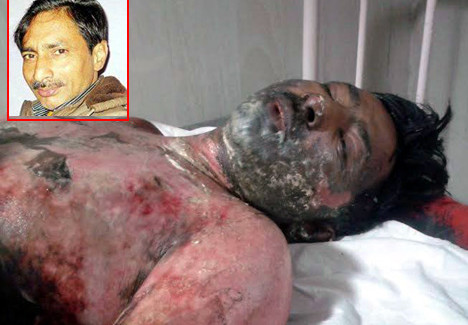Editorial: "Tragic Hero" Jagendra Singh and his freedom sellers
“Liberty of speech means that it is unassailed even when the speech hurts; Liberty of Press can be said to be truly respected when the Press can comment in the severest terms upon and even misrepresent matters.” – Mohandas Gandhi
Mainstream media is the 4th estate of India’s democracy, whereas social media is the 5th estate. Indian democracy doesn’t officially claim “social media” as the 5th estate, because it fears its “anarchic rule of spontaneous order.”
Yet I came to know about Jagendra Singh through social media rather than the mainstream. Mainstream media is unlikely to make it a quick (prime time) “headline” because they are too busy celebrating their loud anchoring and voiceless journalism.
Despite India winning its so-called independence in 1947, many press laws are still draconian, archaic, and colonial. The only thing that has “changed” in India is the skin color of the rulers. Ceteris paribus, media freedom remains static too.
Anyways, the Shahjahanpur-based journalist, Jagendra Singh, kept a Facebook page that was updated with reports written by him, including several posts on the Uttar Pradesh’s dairy development minister, Ram Murti Verma. In one, he alleged that Verma didn’t want another leader to become a Member of the Legislative Council (MLC) and was making political moves to prevent it, and in other posts he alleged that Verma and his accomplices were guilty of gang-raping an anganwadi (underprivileged childcare) worker. He also accused Verma’s men of planning to attack the gang-rape victim’s home and even questioned how Verma had accumulated so much wealth. After the posts, Singh was attacked by men allegedly close to the minister on April 28.
Then came the incident on June 1. His two sons testify that Singh was set on fire by a group of police officers and goons allegedly allied with State Minister Ram Murti Verma. He battled for life for a week at a hospital in Lucknow before he died on June 8. In a dying declaration on video, shot before he breathed his last because of burns, Singh asked: “Why did they have to burn me? If the Minister and his people had something against me, they could have hit me and beaten me, instead of pouring kerosene over me and burning me.”
His death has provoked me to also touch upon the status of media freedom in India. Here I defend “media freedom,” in general. This doesn’t mean that I also defend “celeb journalists” who armchair in their air-conditioned offices and offer speeches on “press freedom.” These so-called reporters are more compatible to sell media freedom to the State over a bottle of whisky with a bureaucrat, but rather real journalists who follow leads, dig for facts, investigate stories, and expose hidden information. As a former journalist, I can confess that I was told to manipulate scripts in my past to solace people’s ignorance. What people see is just as a tip of an iceberg. To tell you recent stories:
In 2001, Tehelka, then a news portal and now a magazine, was banned after it exposed political corruption in India’s defence sector.
In April 2003, The Hindu ran two articles criticizing Tamil Nadu Chief Minister Jayalalithaa for expelling and jailing opposition members from the state legislature. Jayalalithaa retaliated by filing 17 criminal defamation cases and ordering five senior editors of the newspaper to be jailed for 15 days each.
In August 2007, members of the right-wing political party Shiv Sena vandalized the office of Outlook after the magazine published an article listing the party supremo as a “Villain.” More recently, in April 2012, Jadavpur University professor Ambikesh Mahapatra was arrested for circulating a cartoon of West Bengal Chief Minister Mamata Banerjee.
In September 2012, Azhar Kadri, a reporter for the Kashmir Tribune, newspaper was beaten up severely by the police while covering a protest in Srinagar.
There is so much more.
In the Fifteenth general elections in 2009, reports highlighted payment of money by candidates to the representatives of media houses to ensure positive coverage. As I noted, media is called the 4th pillar of a democracy. It is a platform to debate and form public opinions. One of the greatest dangers to democratic society is takeover of media platforms by politicians, the government, a State-backed corporate world, and/or elite who desire to influence and form social thought and control opinions.
Another major reason why the world’s biggest democracy dropped to the 140th rank in press freedom (2013 World Press Freedom Index by Reporters Without Borders) is because India has been pushing for global Internet governance. The unpopular notion of internet censorship continues to be a major obstacle to free access to information. Authorities insist on censoring the web and imposing more and more taboos everywhere, inciting criticism from a diversity of nations. Nota bene, the factors deciding the ranking are: 1) legal framework for the media, 2) press environment and self-censorship, and 3) violence against journalists, netizens, and media assistants.
Remember that your government is armed with the power of coercion and it often encroaches upon the freedom of the press by exploiting restrictive laws governing criminal defamation, contempt of court, and national security to silence reporters” accounts of corruption. If that doesn’t help, the political parties may even resort to threats and violence.
I hope Jagendra’s sacrifice doesn’t go waste, and meanwhile you may google “Centralised Monitoring System” to learn how you’re being snooped by the government.

